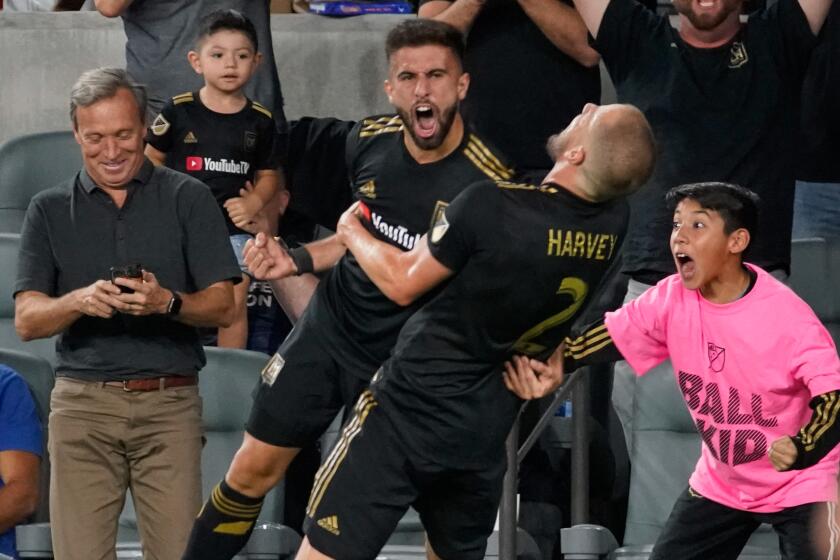Column: MLS labor negotiations could be a messy situation
- Share via
The last time Major League Soccer negotiated a collective bargaining agreement with its union, both sides braced for a work stoppage just 72 hours before the 2015 season was scheduled to begin.
The league wouldn’t budge from its final offer, one the union insisted it would not accept. The players voted against the offer and a strike appeared imminent.
The next morning, that determination dissolved, the union surrendered and a walkout was averted. So now, with negotiations for a new CBA accelerating, the union is bracing for another showdown and says its members are more unified than ever.
The walkout that was averted four years ago might not be avoidable this time.
“The reality is all collective bargaining on the labor side involves preparing for a work stoppage,” said Bob Foose, executive director of the MLS Players Assn. “We’ve been talking about that for several years now and the guys are very well-prepared.
“[But] it’s certainly not our goal.”
That renewed unity was borne partly out of frustration because the players return to the bargaining table to face many of the same topics that dominated the last negotiations, free agency and pay among the most pressing. Add to that a union demand for more charter flights, which is something the players say has increasingly become a competitive issue with frequent flight delays and cancellations disrupting both training and post-game recovery.
“What all that boils down to is if it’s going to be a league of choice, it has to look and feel a whole lot more like what other leagues around the world look like,” Foose said.
The current CBA, the third since the players’ association was formed in 2003, expires Jan. 31, less than a month before the 2020 season kicks off. And though Foose said the two sides have already opened discussions, he doesn’t expect a quick or tidy resolution.
LAFC coach Bob Bradley believes the team’s resilient effort, led by Adama Diomande, bodes well, while Zlatan Ibrahimovic’s MLS career seems like it’s ending.
“Collective bargaining only ends one way. It ends with an agreement,” he said. “We have talked a whole lot more — and more substantively — during this CBA than ever before. Which is a good thing.
“That said, things will heat up as you get closer. Unfortunately just sort of the way collective bargaining works, it’s that urgency of the deadline that tends to get things done.”
Free agency is perhaps the biggest issue that was left unsettled in the last negotiations. Due to MLS having a single-entity structure in which the players and teams are owned by the league and managed by investor-operators, the league would essentially be bidding against itself for players if free agency worked in soccer the way it does in every other major U.S. professional league.
Five years ago, the league agreed to guidelines that granted freedom of movement to players who are not under contract, aged 28 or older with eight years of MLS service. Although those limited terms fell well short of what the players were asking for, they accepted them to avert a strike.
The union’s seven-man executive board and the 79 players on the bargaining committee are seeking a better deal this time.
“Guys want to be able to choose where they work and where they live,” Foose said. “We want to see substantial changes on that front.”
Spending and roster construction are also front-burner issues for the union. MLS has among the most complex and opaque financial rules of any major league, limiting what teams can spend on players while also providing exceptions. For example, teams can go beyond the salary cap — currently $4.24 million — to sign three designated players, whose contracts are not limited. They can also use an additional $4 million in targeted allocation money to pay down the cost of other signings, keeping those salaries below the cap.
The union doesn’t like TAM, though, because the rules for its use are so limited, it has primarily become a vehicle to fund new contracts rather than give raises to existing players.
“Our belief is all players should be able to compete for all dollars that are in the system,” Foose said.
Sign up for our free soccer newsletter >>
“The whole system is sort of nonsensical. The exact same player with the exact same contract could be a DP, could be a TAM player or could be neither.”
While the union has been warning of a strike, the league has remained mostly quiet. Mark Abbott, the league’s president and deputy commissioner, said MLS has opened its books to the union, erasing much of the mistrust that colored previous negotiations. Yet Abbott too cautioned that “you never can tell with collective bargaining how things will come out.”
The union wasn’t ready to strike five years ago, but this time, a fund has been established and players have, for years, been asked to be prepared financially for a walkout — one that will be difficult for the nearly 25% of its membership who reportedly make no more than $75,000 a year.
“The league is in a great position. The players are in a great position,” LAFC defender Steven Beitashour said. “I’m confident something will get worked out for both sides.
“Whether that’s a strike or not, that’s to be seen.”








